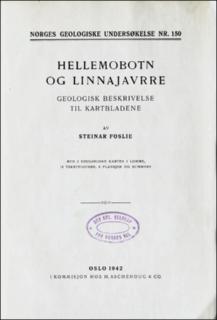Hellemobotn og Linnajavrre. Geologisk beskrivelse til kartbladene.
Journal article

Åpne
Permanent lenke
https://hdl.handle.net/11250/2674534Utgivelsesdato
1942Metadata
Vis full innførselSamlinger
- Artikler [1064]
Sammendrag
The situation of the maps is shown on p. 6. They form the southern continuation of the map Tysfjord, recently described by the author (NGU no. 149). The petrology and chemistry of the rocks are reserved for a special paper. The main part of the district is highland with an average elevation of 6-700 m above sea level, as shown on the hypsographic curves, fig. 13. It has been completely glaciated and almost deprived of dÅbris and glacial drift. The highland is cut abruptly by the fjords, which penetrate nearly to the watershed, leaving only a narrow strip of land draining westwards to the Atlantic. Norway has here its narrowest part, the distance from the head of Hellemofjord to the frontier amounting to only 6.3 km. The extreme westerly position of the watershed is a main geomorphological feature of the district. A consequence of this are also the numerous ice-dammed lakes, which have existed here in late glacial time. Their situation is shown on fig. 2. Several of them are smaller local lakes west of the watershed. The main ice lakes were dammed against the Scandinavian watershed, and only a small part of them have therefore covered Norwegian territory. From north to south they are: Suorke Lake, which drained through Tappa Korso (Rieppi) to Mannfjord, Store Lule Lake to Hellemofjord, and Salojaure Lake to Sørfolla.
